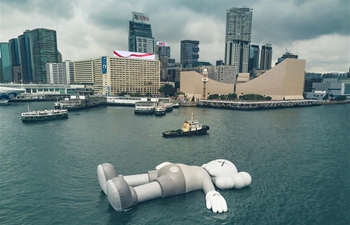LOS ANGELES, March 22 (Xinhua) -- NASA's InSight lander mission team said on Friday more imaging and testing are planned to further study InSight's heat probe, which has hit a snag and paused digging.
The testing includes a new round of hammering, which was last attempted on March 2, said a release of the mission team.
The heat probe, known as the Heat Flow and Physical Properties Probe (HP3), is designed to dig up to five meters below the Martian surface and measure the heat coming from inside the Red Planet.
After beginning to hammer itself into the soil on Feb. 28, the 16-inch-long (about 40-centimeter-long) probe reached about three fourths of the way out of its housing structure before stopping.
According to the team, there is still little clarity as to whether the "mole" -- the nickname for the self-hammering spike which is part of HP3 -- is being blocked by a single rock or a layer of gravel.
There is also the possibility that the probe or its cable might be stuck on something inside the instrument's protective housing.
If the probe could eventually dig at least three meters underground, the mission team can get useful information about the Martian interior.
Later this month, the team plans to conduct a 10-to-15-minute hammering test, which will allow InSight's seismometer to "listen" to the mole striking whatever obstacle it has hit, offering possible clues as to what may be blocking it.
Meanwhile, the camera on InSight's robotic arm will photograph the mole's support structure in the hopes of catching any possible motion induced by the mole during hammering.
In April, a replica of HP3 will be shipped to NASA's Jet Propulsion Laboratory (JPL) in Pasadena, California, which will allow JPL's team to begin testing in concert with German Aerospace Center engineers working with similar models in Bremen, Germany, according to the mission team.
InSight landed safely on Mars on Nov. 26 last year, kicking off a two-year mission to explore the deep interior of the Red Planet.
The heat flow probe is one of the three instruments InSight brought to Mars. The other two are the Seismic Experiment for Interior Structure (SEIS) for recording "Marsquakes," and the Rotation and Interior Structure Experiment (RISE) for collecting preliminary data on the planet's core.













